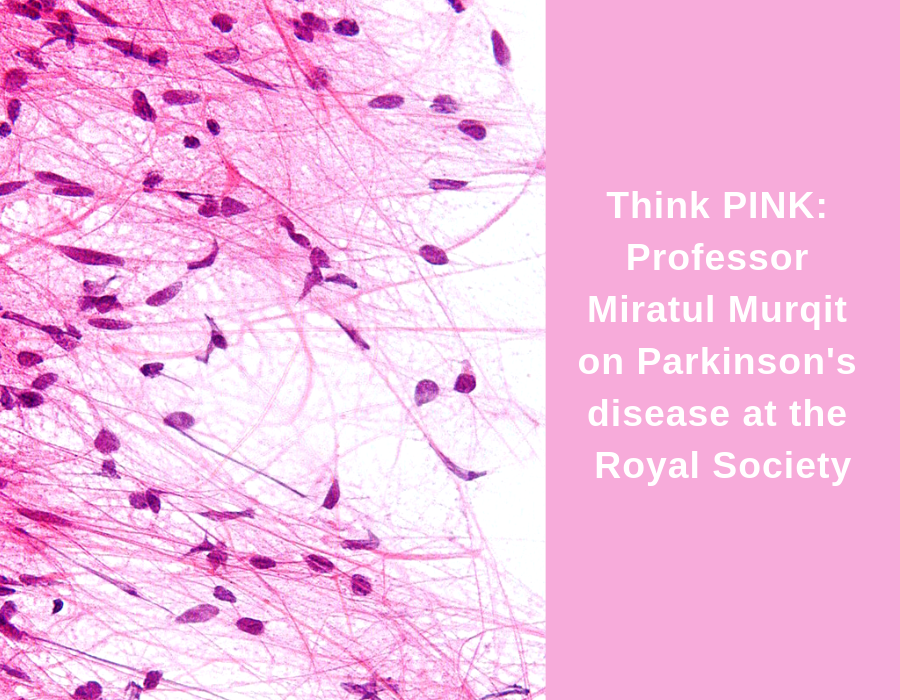Roisin Conneely
Last Thursday Arzo and Roisin went along to the Francis Crick medal lecture at the Royal Society in London. The Francis Crick medal is awarded each year to a scientist who has made significant contributions to biological science, usually in the fields of molecular biology and neuroscience.

This year’s recipient was Professor Miratul Murqit of Dundee University, for his work on the role of cell signalling pathways in Parkinson’s disease. Read on for an overview of his talk and what we learned!

Professor Muquit began by giving a brief history of the discovery of Parkinson’s disease. In 1817, James Parkinson described a condition called ‘shaking palsy’, which he observed in some of his patients at his practice in Hoxton, as well as a handful of individuals he witnessed out and about on the streets of London. The characteristic symptoms of this condition were noted as involuntary motions, tremors, and a stooped posture. Sadly, Parkinson’s research wasn’t really picked up on until much later, when advances in technology, such as Golgi’s novel methods for staining brain cells, allowed scientists to examine neurodegeneration further.
Alois Alzheimer’s lab in Munich, in 1912, began looking at structural changes in the brain. One of his colleagues, Fritz Heinrich Lewy, examined 25 ‘Parkinson-like’ brains, and observed filamentous inclusions in the nerve cells, and concluded that they contained a large protein component. In 1919, Konstantin Tretiakoff observed similar masses of protein in the substantia nigra of the brain, naming them ‘Lewy bodies’.
In 1857, Avid Carlsson unveiled the role of dopamine in movement; by administering a substance called reserpine to rabbits, making them Parkinson-like. When reserpine was administered along with L-dopa, the precursor to dopamine, these symptoms were reversed. This knowledge ultimately led to the development of Levadopa as a Parkinson’s therapy, however, it only aids symptoms, rather than actually curing the disease.

So why is dopamine so important in Parkinson’s disease? Well, cells that release dopamine are very energetic, or metabolic, because they are so active. This makes them vulnerable to mitochondrial damage – as the memes remind us, the mitochondrion is the powerhouse of the cell, and any powerhouse that has to work as hard as the ones producing dopamine, is bound to break down sooner or later. Normally, there are processes in place to get rid of cells with faulty mitochondria, but as these mitochondria are located in nerve cells, this makes such a process a bit trickier. Neurones generally don’t regenerate, so the ones we’re born with need to last us a lifetime, meaning it’s not ideal to get rid of any of them, even if they do have malfunctioning mitochondria.
Any powerhouse that has to work as hard as the ones producing dopamine, is bound to break down sooner or later
Professor Muquit then went on to describe his own research into Parkinson’s disease. One of the key players in the cell signalling cascade involved in the disease is a gene called PRKN, which encodes an enzyme called Parkin. Parkin is a type of enzyme known as a ligase, and is involved in recruiting other molecules, called ubiquitin, onto proteins to modify them and their functions. Parkin is activated by another gene, called PINK1, which codes for a type of an enzyme called a kinase, which is involved in adding phosphates on to proteins, also to modify them. PINK1 usually gets activated when the mitochondrion gets damaged, beginning the cell signalling cascade shown in an image from Professor Murquit’s presentation, below. This cascade usually leads to the marking of damaged mitochondria for destruction.

When PINK1 or Parkin are mutated faulty mitochondria don’t get removed, accumulating damage in nerve cells, allowing Parkinson’s disease can develop (side note; there are actually around 20 genes known to be involved in the onset of Parkinson’s disease, but Professor Murquit’s research focuses on these two).
Professor Murquit’s research into understanding this PINK1 pathway means that there is new hope that this signalling cascade can be manipulated and targeted with new drugs to stop the mitochondrial vicious cycle. His work so far suggests that small molecules that can activate PINK1 could be used to return the pathway to its functional state, and thus offer a potential therapy.
Overall, we thoroughly enjoyed this talk, which presented the molecular mechanisms underlying Parkinson’s disease in a simple and clear to follow way. There is still a long way to go before a cure for this debilitating disease is found, but understanding how it works and developing new methods to manipulate the pathways involved, means we are now closer than we’ve ever been before.
You can read more on Professor Murquit’s research here and watch the Francis Crick Lecture 2019 in full here.




